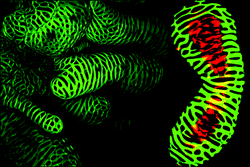The art in science of microTAS
Michael
Gaitan
a and
Harp
Minhas
b
aNational Institute of Standards and Technology (NIST), Gaithersburg MD 20899, USA
bRoyal Society of Chemistry
 | ||
| Fig. 1 Dong Jin Shin of Johns Hopkins University (center) receives the 4th annual μTAS Art in Science Award, presented by Michael Gaitan of NIST (left) and Harpal Minhas of LOC/RSC (right). | ||
 | ||
| Fig. 2 Winner: Yin and Yang in Droplet, submitted by Dong Jin Shin of Johns Hopkins University. | ||
The μTAS Art in Science Award was established in 2008 to commemorate the inspiration of scientific discovery and technological advancement. In the spirit of this award we ask how does technology innovation take place? Does it come from the constant intensity of thinking and work or from the in-between times when the mind becomes still? Thus, this year’s winner is doubly significant as yin and yang become sensible from an initial quiescence or emptiness (sometimes symbolized by an empty circle), and continues moving until quiescence is reached again, like the ripples from a stone dropped in a pool–first you have the waves expanding outward until they dissipate and the pool once again becomes still.
In his foreword to the Tao Te Ching (Tao Te Ching: A New English Translation, Perennial Classics, 2000), Stephen Mitchell writes about wei wu wei, literally translated as doing not-doing. “A good athlete can enter a state of body-awareness in which the right stroke or the right movement happens by itself, effortlessly, without any interference of the conscious will. This is a paradigm for non-action: the purest and most effective form of action. The game plays the game; the poem writes the poem; we can’t tell the dancer from the dance.”
There has been long discussion on the origin and personal attributes of innovative thinkers. In his book Sudden Genius? : The Gradual Path to Creative Breakthroughs (Oxford Press, 2010), Andrew Robinson writes “One of the most admired scientists of the last century, Linus Pauling, was once asked by a student: ‘Dr Pauling, how do you have so many good ideas?’ Pauling thought for a moment and replied: ‘Well, David, I have a lot of ideas and throw away the bad ones.’ ”
A. E. Housman wrote in his essay on The Name and Nature of Poetry (1933) “Having drunk a pint of beer at luncheon … I would go out for a walk of two or three hours. As I went along, thinking of nothing in particular, only looking at things around me and following the progress of the seasons, there would flow into my mind, with sudden and unaccountable emotion, sometimes a line or two of verse, sometimes a whole stanza at once, accompanied, not preceded, by a vague notion of the poem which they were destined.”
The selection committee for the Art in Science award consisted of Prof. Yoshinobu Baba (Nagoya University), Prof. Je-Kyun Park (KAIST), Albert van den Berg (University of Twente), Harp Minhas (LOC/RSC), and Michael Gaitan (NIST). Forty high quality submissions were carefully considered for visual appeal, originality, scientific merit, simplicity from complexity and color as well as suitability for a LOC front cover.
The 3 top runners up for this year’s award were:
• Knitting by Christophe Provin of the Institute of Industrial Science, University of Tokyo (Fig. 3).
• A Microfluidic Maze from Nature Micro-world by Maged Serag of Nagoya University (Fig. 4).
• High-throughput microfluidic single-cell RT-qPCR by Michael Van Insberghe of the University of British Columbia (Fig. 5).
 | ||
| Fig. 3 Knitting, submitted by Christophe Provin of the University of Tokyo. An artistic blur of wrinkled PDMS. Colors have been enhanced to highlight the structure. | ||
 | ||
| Fig. 4 A Microfluidic Maze from Nature Micro-world submitted by Maged Serag of Nagoya University. The 3D-reconstructed confocal images show a sophisticated network (a maze) of plant microfluidic vessels. | ||
 | ||
| Fig. 5 High-throughput microfluidic single-cell RT-qPCR by Michael Van Insberghe of the University of British Columbia. False-coloured confocal laser scan showing a section of the array from a microfluidic device for high-throughput single cell gene expression analysis. Each unit of the array features a trap for capturing a single cell and compound chambers for lysis, reverse transcription and measurement of transcript abundance by quantitative polymerase chain reaction. | ||
If you believe you have an artistic eye and are inspired by this award or indeed believe you can produce more interesting images representing any subject within the scope of the μTAS conference, you are now invited to submit your own images for consideration for the 2012 competition. Please remember that the rules state that the winner must be registered and in attendance at this year’s μTAS conference in Okinawa, Japan (http://www.microtas12.org/index.html) if you submit an image and you are not in attendance, the prize will be given to the image in second place.
The prize is sponsored and supported by the MictoTAS Conference, the Chemical and Biological Microsystems Society, the National Institute of Standards & Technologies (NIST) together with the Lab on a Chip journal and consists of $2000, a certificate and the coveted front cover of the Lab on a Chip journal. Please contact the μTAS conference for further details for the submission of your images.
Finally, we look forward to receiving your entries for this competition and hope to see you all in Okinawa, Japan, in October!
Stop press!
Lab on a chip and Corning Inc also support and award the LOC/Corning Inc Pioneers Lecture at the microTAS conference ($5000 and a Medal) nominations for this are now also welcome. For further information please see the following website: http://blogs.rsc.org/lc/category/pioneers-of-miniaturisation-prize/References
- Y. Zhang, D. J. Shin and T. H. Wang, “Detecting Genetic Variations in a Droplet”, micro-TAS, 2011, 1179–1181 Search PubMed.
| This journal is © The Royal Society of Chemistry 2012 |
